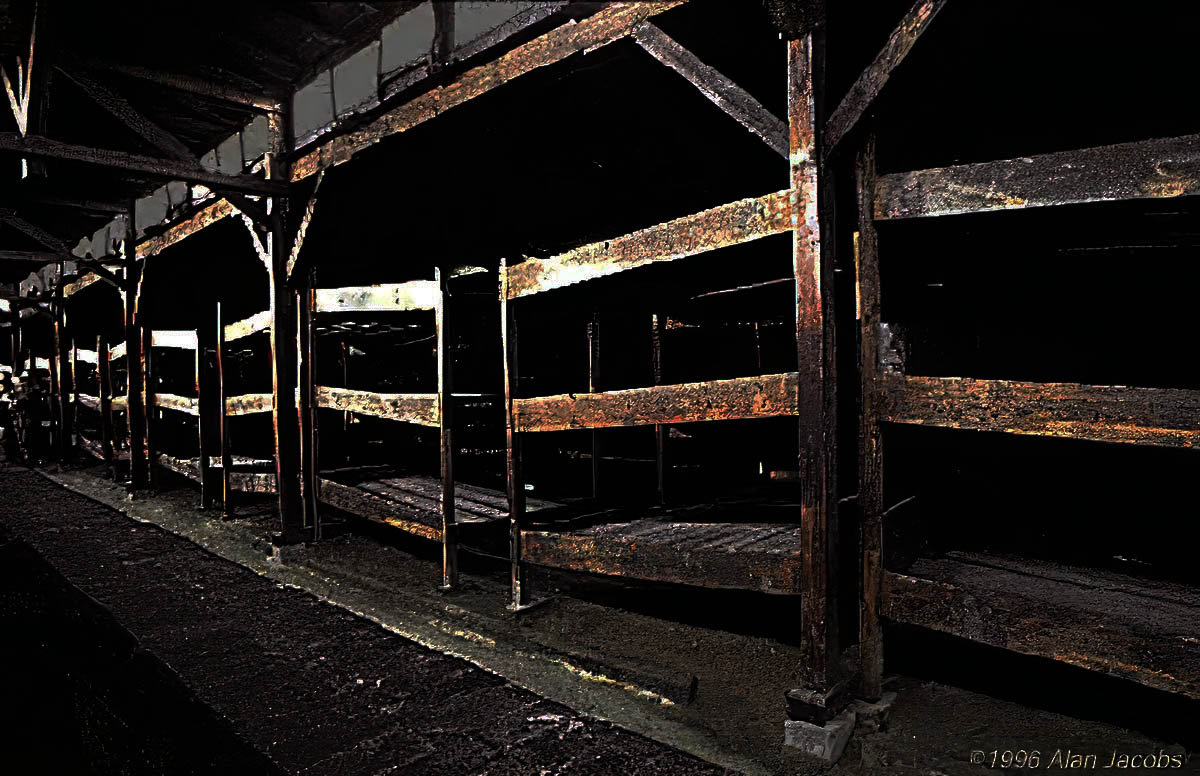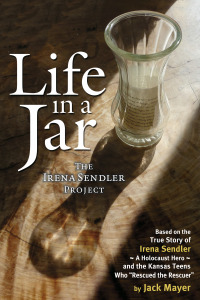Auschwitz Paintings by Survivors – Part 1
Part 1
This exhibit contrasts contemporary photographs of these two camps, with images of what they were like 1940-45 as remembered by artist-survivors.
Much of the art was created soon after their liberation. Their art is the only visual record of day-to-day existence in Auschwitz/Birkenau.
1. Inside a Barrack in Auschwitz II, Birkenau
Wooden barracks in Auschwitz II- Birkenau, BIIA.
These barracks were actually prefabricated horse stables originally made for use on the eastern Front, against the Soviet Union. Even the rings for tying horses were in place along the sides.
The wooden bunks, or “hutches” as they are sometimes called, contained as many as six prisoners on each shelf.
Originally intended to house 250 prisoners, these barracks sometimes contained as many as a thousand.
Pen and Ink: Mieczyslaw Koscielniak Wooden barracks in Auschwitz II-
Reproduction courtesy of Auschwitz
Museum Archive, 1980

The wooden bunks, or “hutches” as they are sometimes called, sometime contained as many as six prisoners on each shelf.
During the war, these hutches were painted white, feigning a semblance of cleanliness.
Originally intended to house 250 prisoners, these barracks sometimes contained as many as a thousand.
Photo: Alan Jacobs
2. A Street in the Women’s Camp
Women in the cold, in the women’s camp at Auschwitz II-Birkenau, B1A, probably just before the Appel, or Roll Call. The only well-fed woman in the scene is at lower left with the armband CAPO.
Capos were prisoners themselves and work supervisors or foreman. They held the power of life and death over their charges. Many of them were very brutal, even beating inmates to death. Some others helped the prisoners where they could, though this was difficult and perilous.
Painting: Janina Tollik
Reproduction courtesy of Auschwitz Museum Archive, 1980
3. Interrogation in Block 11
This scene depicts the basement of the infamous Block 11 in Auschwitz I, the first Auschwitz camp and administrative center.
If Auschwitz was the end of the line either for gassing or for forced labor, Block 11 was the end of the line at the end of the line.
After a person found oneself in a concentration, labor and extermination camp, it was possible to be incarcerated in the camp prison, Block 11.
Here standup cells were employed, as well as suffocation and internment cells. In a standup cell, as many as three prisoners were made to crawl in through a small door on the floor, and then stand in a very small space making it impossible to sit.
Food rations were scarce and sanitary conditions were beyond filthy. One can imagine various scenarios, possibly an interrogation.
Exact description of this particular scene is unavailable. On July 31, 1941, in reprisal for one prisoner’s escape, ten men were chosen to die.
Father Kolbe offered himself in place of a young husband and father and was sent to the basement of Block 11.
He was the last of the 10 to die, having been shot after enduring two weeks of starvation, thirst, and neglect in an isolation cell.
Pope John Paul II canonized him in 1981.
Watercolor: Wladyslaw Siwek
Reproduction courtesy of Auschwitz Museum Archive, 1980
This scene depicts the basement of the infamous Block 11 in Auschwitz I, the first Auschwitz camp and administrative center.
If Auschwitz was the end of the line either for gassing or for forced labor, Block 11 was the end of the line at the end of the line.
After a person found oneself in a concentration, labor and extermination camp, it was possible to be incarcerated in the camp prison, Block 11.
Here standup cells were employed, as well as suffocation and internment cells in a standup cell, as many as three prisoners were made to crawl in through a small door on the floor, and then stand in a very small space making it impossible to sit.
Food rations were scarce and sanitary conditions were beyond filthy. One can imagine various scenarios, possibly an interrogation.
On July 31, 1941, in reprisal for one prisoner’s escape, ten men were chosen to die. Father Kolbe offered himself in place of a young husband and father and was sent to the basement of Block 11.
He was the last of the 10 to die, having been shot after enduring two weeks of starvation, thirst, and neglect in an isolation cell.
Pope John Paul II canonized him in 1981.
Photo: Alan Jacobs
4. A Group of New Arrivals
Arrival into the Auschwitz camp. Just behind the prisoner’s backs and to their left is the guard tower at the main entrance to the camp.
Barely discernible are the words at the entrance gate:
Arbeit Macht Frei:
Work Makes Free.
This cynical slogan was posted at the entrance of many of the camps. If the gas chamber, or shooting wall didn’t kill one, the labor was very likely to do so.
From the moment of entry, there was a calculated process of dehumanization; the surest way to control prisoners. People in this state do not rebel.
It also was a way to reinforce the Nazi belief that these prisoners were inferior human beings, or, in the case of the Jews and Gypsies, not human at all, but vermin.
Here we see SS guards and officers, armed with pistols and clubs screaming at the new arrivals, or standing aside in attitudes of power and superiority.
Watercolor: Wladyslaw Siwek
Reproduction courtesy of Auschwitz Museum Archive, 1980
Arrival into the Auschwitz camp. Just behind the prisoner’s backs and to their left is the guard tower at the main entrance to the camp.
Barely discernible are the words at the entrance gate:
Arbeit Macht Frei:
Work Makes Free.
This cynical slogan was posted at the entrance of many of the camps. If the gas chamber, or shooting wall didn’t kill one, the labor was very likely to do so.
From the moment of entry, there was a calculated process of dehumanization; the surest way to control prisoners. People in this state do not rebel.
It also was a way to reinforce the Nazi belief that these prisoners were inferior human beings, or, in the case of the Jews and Gypsies, not human at all, but vermin.
Photo: Alan Jacobs
5. To the Gas
The entrance to the Krankenbau, or camp hospital, courtyard. We see prisoners who have come to the hospital seeking, if nothing else, a brief respite from the killing work.
Those too ill to work were killed by phenol injection to the heart, or sent to the gas. Here prisoners are whipped onto a truck for transport to the gas chamber.
Water Color: Jerzy Potrzebowski
Reproduction courtesy of Auschwitz Museum Archive, 1980
6. Going to Sleep in the Night
Scene shows prisoner official in charge of the block, a Blockeltester, kicking and beating prisoners into bed, if one can call it that. They had endured another day of slave labor with insufficient food rations.
This scene is in the original Auschwitz camp, (Auschwitz I). The exact location is there today, the entire camp halving been turned into huge museum, research archive and memorial.
Water Color: Jerzy Potrzebowski
Reproduction courtesy of Auschwitz Museum Archive, 1980




